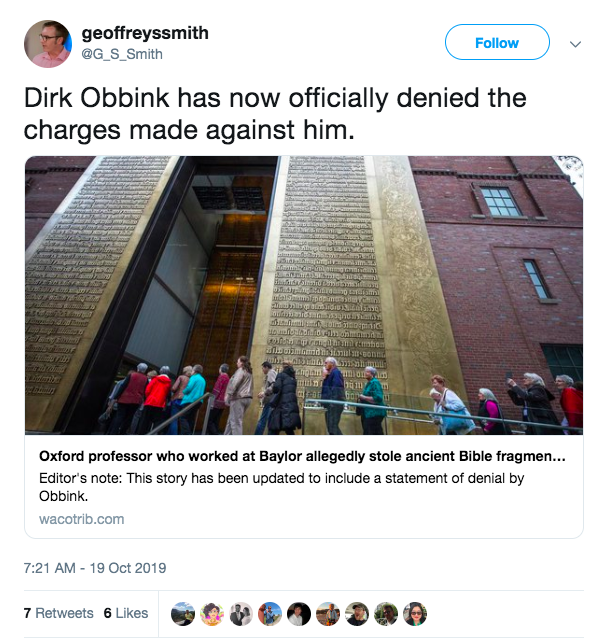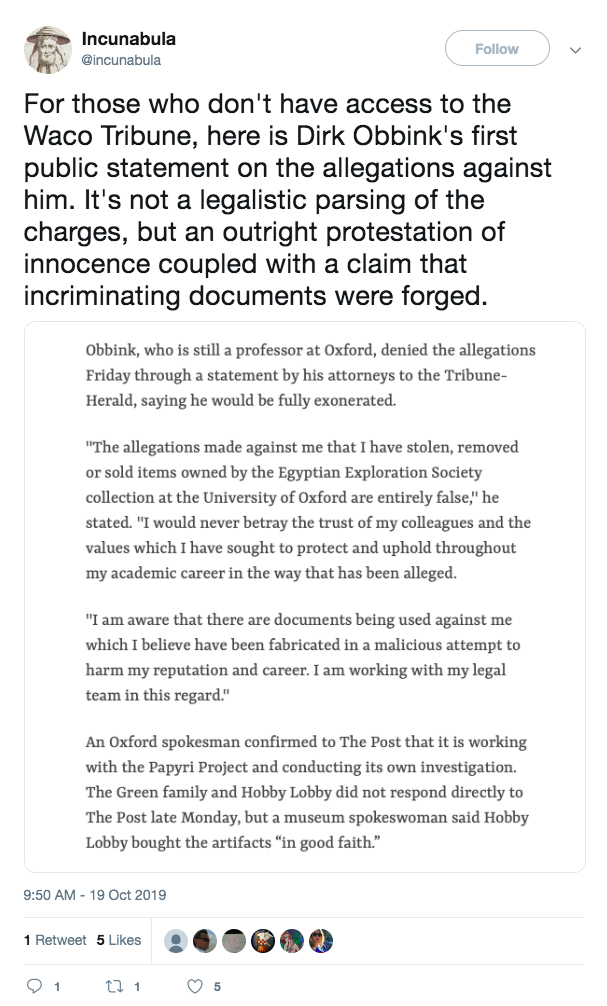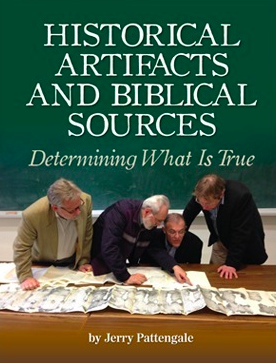Professor Dirk Obbink has issued a public statement emphatically denying the accusations that he sold Oxyrhynchus papyri to Hobby Lobby. The local Texas newspaper to which Prof. Obbink chose to communicate his statement (the Waco Tribune-Herald) is not available online in Europe:

But Geoffrey Smith of the University of Texas at Austin broke the news on twitter:

Another twitter user kindly provided the full text of the relevant portion of the article, including the statement made by Obbink’s attorneys:

I assume the reference to “documents being used against me” means the receipts and invoices in the possession of the Hobby Lobby / Museum of the Bible organization. If that is correct, then the charge that these documents were “fabricated” is further evidence of the complete breakdown of a long and multifaceted relationship between Prof. Obbink and Scott Carroll, Jerry Pattengale, and the Hobby Lobby organization.

I would hope that all parties involved in this dispute have reported their sides of the story to the appropriate law enforcement agencies. It will be interesting to see how that plays out.
If this denial is truthful, it of course raises the question of how the 11 manuscripts made their way from Oxford to the Green Collection in the US. But recall the charges laid out by the Egypt Exploration Society (EES) were not just about the theft of manuscripts. The accusations also involved a coordinated manipulation of the card catalog system for unpublished Oxyrhynchus papyri. The EES briefly described this system back in 2018:
“EES records include a photograph and brief record card for each papyrus awaiting publication, which were prepared to assist the General Editors in selecting papyri for future volumes. The cards were created without detailed study of the texts and without access to today’s online search tools.”
Now here is the EES statement about the stolen manuscripts from earlier this week:
“The EES has so far identified thirteen texts from its collection, twelve on papyrus and one on parchment, all with biblical or related content, which are currently held by the [Museum of the Bible] (see the attached list). These texts were taken without authorisation from the EES, and in most of the thirteen cases the catalogue card and photograph are also missing. Fortunately, the EES has back-up records which enable us to identify missing unpublished texts.”
That last observation about tampering with the card system would really appear to narrow down the list of people who could have pulled this off. How many people would have the access and knowledge to do this? Past and present general editors of The Oxyrhynchus Papyri series (so, what? about 20 people?), and who else?
As I have noted on multiple occasions, the card system used for the unpublished papyri is very obscure to outsiders and has never been publicly explained. The number of people with both access to the unpublished papyri and detailed knowledge of (and access to) the card system seems to be extremely small. It would be illuminating if someone at Oxford or the EES could say just how many people have had access to that system of cards over the last ten years.
In the meantime, the working list of papyri of dubious origins grows. Papyrus fragments of Exodus and Isaiah have been added today.

This cannot get any more bizarre. It just can’t.
I’m completely flabbergasted. His signature can be compared with other things he’s signed. He knows all about handwriting analysis through his own work!
Something else that I don’t quite understand is if Obbink was already in trouble over the Sappho fragment, why did EES allow him to publish the Mark fragment? Why didn’t they have someone else do that? And why didn’t the EES come forward immediately when they learned it was their fragment or at least make an announcement about it once it was published? They kept quiet.
Yes, I think there is a lot more to learn about exactly who knew what and when did they know it.
I think the unidentified man on the picture is Dead Sea Scrolls scholar Émile Puech of École Biblique.
Many thanks!
Any guesses why the back-up records weren’t similarly tampered with? Seems like an odd oversight for someone with knowledge of and access to the card catalogue.
I don’t know this, but it may be that the back-up records are at the EES in London.
Hi Brent did you get my email? I’d be interested to know if possible to chase up this:
https://evangelicaltextualcriticism.blogspot.com/2012/01/new-fragment-of-romans-9-and-10.html
I don’t want to speculate too much, but Bill’s former student may be the person who made the presentation on “Discovering an Unknown Papyrus” here:
Click to access 2012MidwestSBL_AOS_ASOR_ProgramAbstracts.pdf
Possibly you could chase up if that papyrus is “Quotation of Hebrews: P.Oxy. inv. 105/188(c). [PAP.000378]”, get the records of that presentation. Even if it’s a different papyrus she and Bill Warren should answer questions regarding their comments that P131 came from a mummy mask (Bill just relaid the information he was told, but **who** did he hear it from?)
What about the “200” other NT manuscripts they claim came from mummy cartonnage?
https://www.josh.org/resources/apologetics/discover-the-evidence/
Click to access Bibliographical-Test-Update-02.04.16.pdf
Anyway, I hope SBL panel goes well and that someone can record the event so those of us who are interested can see what transpired!
Thanks for the comment and the links. Yes, something strange has gone on with a number of these fragments. Some of the pieces (like the fragment of Romans) that we now know were stolen from the EES were said by Scott Carroll and others to have been extracted from cartonnage. The sorts of “eyewitness” claims to which you link in the ETC blog comments would seem to raise the possibility that these pieces may have been planted in pieces of cartonnage and then “extracted” in front of audiences. A similar kind of suggestion has actually already been raised (again in the comments of the ETC blog: http://evangelicaltextualcriticism.blogspot.com/2019/06/lingering-questions-about-first-century.html?showComment=1562122592275#c8489962958022158632 )
The other side of this is what was the potential benefit to the Buyers? Investigative Reporter Candida Moss has already reported in on the subject:
https://www.thedailybeast.com/how-the-museum-of-the-bible-exploits-jewish-traditionand-saves-its-evangelical-christian-donors-millions
Per the Internal Revenue Code and as outlined by IRS Publication 526:
Click to access p526.pdf
For donations of appreciated Collectibles, the potential tax deduction is the Fair Market Value at the time of donation. Let’s assume we have a billionaire who hates paying taxes:
Max Bialystock: Assume away.
Mr. Billionaire purchases Collectible (which includes religious artifacts) for God knows what and then (after a year) has it appraised for lots more and takes a tax deduction for lots more. Let the Reader understand that Hobby Lobby is a PRIVATE company so God does not reveal the purchase price.
And who would be a good person to have appraised the Collectible? Someone who is an expert in that specific collectible, has an academic background and is an experienced dealer of that collectible at the very highest levels. Who would have the authority to dispute this appraisal?
I picture Obbink having a commercial just like George Zimmer of The Men’s Warehouse used to have:
“Hi, I’m Dirk Obbink of The Mees Papyri Warehouse. This ancient fragment of GMark, two million dollars at EES, the same fragment, 1 million dollars at The Mees Papyri Warehouse. How can I afford to do that, you ask? Simple, this is the exact same fragment from EES. I stole it. You pay me 1 million dollars for it and that’s 1 million dollars profit. Those are the facts I guarantee it!”
Seriously, looking forward, is anyone going to press charges against Obbink? MOTB/Hobby Lobby could make a large grant to EES and Oxford and a large settlement with Obbink. But just in case, Obbink wants to add that there is also a grail buried in the basement of his for sale Seaside Castle in Nazareth (along with one or two research assistants).
https://www.christianitytoday.com/ct/2019/june-web-only/first-century-mark-pattengale-inside-saga.html
The ‘First-Century Mark’ Saga from Inside the Room
My reflections after eight years of silence.
JERRY PATTENGALE
“Eventually, all four pieces were purchased in 2013 for a considerable sum—though at a fraction of their value (even taking the later dates our researchers suggested).”
And presumably “value” would be the amount of the tax deduction the purchaser took (or could have taken).
http://ancientassetinvestments.com/wp-content/uploads/2013/12/PlatosPhaedo.pdf:
“2. In the same Schoyen Sale of 10 July 2012 a late 3rd century parchment
fragment of Romans was sold for GBP 310,250 all-in (about
$500,000)(detail follows and in Section 5). a very direct marke
comparable. There is no doubt that $500,000 for this early witness to
Romans was below FMV, given the demand for and paucity of New
Testament witnesses of this period in private hands. I feel confident that the
buyer of the Wyman Romans fragment made a much better “buy” than
the buyer of the Adler Papyri.”
If a late 3rd century frag of Romans was bargain purchased at $ 500,000 then what would a late first century frag of Mark be worth? Especially with Dan Wallace hyping it on the EES Raider’s sidelines like “John” (Madden).
Even better evidence for Fair Market Value than an appraisal by someone like Obbink would be a recent comparable sale. MotB and Andrew Stimer appear to be in the same non-business business so I have faith that they know each other. Two major buyer/sellers working together could in addition to raising faith also raise the going rate for oldie but good newsie fragments. Suppose they in effect each purchase one of the other’s inventory for the about the same God knows what high price. Just a wash at that point. But now the Bar has been set for Fair Market Value for other of their inventory that they can donate and take a tax deduction for Fair Market Value. Even if their cost was “a fraction of their value”. They are the major beneficiaries and Obbink as enabler just wets his parapet.
“I assume the reference to ‘documents being used against me’ means the receipts and invoices in the possession of the Hobby Lobby / Museum of the Bible organization.”
But it could also refer to the EES’s “back-up records which enable us to identify missing unpublished texts”. Or to both.
However, the number of people able to commit such a fraud, if Obbink is being truthful, must still be very small.
Pingback: Friday Varia and Quick Hits | Archaeology of the Mediterranean World
Pingback: Dirk Obbink Discusses Oxyrhynchus “Distribution” Papyri | Variant Readings
Pingback: Biblical Studies Carnival # 165. October 2019 | Bible, Myth, and History
Pingback: The Perennial Problem with the Excavation of Ancient Sites – Yakanak News
Pingback: Contextualizing the New Sappho Information | Variant Readings
If images of artifacts were published on the internet (if you don’t want to spend money on servers, just upload them to WIkimedia Commons), contemporary “stealing” would be over and done for. But, ahem, which collection wants to make materials freely available? (kudos to U Michigan and others, boos to the MotB and their ilk, even the pathetic ways some websites try to make it hard to download images) The whole concept of someone “owning” Scripture is wrong. “freely you have received, freely give,” right?